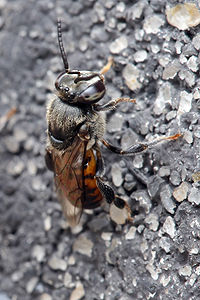
Plasticizing effect of Apis mellifera honey on whey protein isolate films
Sign Up to like & getrecommendations! Published in 2022 at "Biopolymers"
DOI: 10.1002/bip.23519
Abstract: The aims of this study were to analyze the plasticizing effect of Apis mellifera honey on the mechanical, physicochemical and optical properties of whey protein isolate (WPI) films and to compare the results collected with… read more here.
Keywords: wpi films; apis mellifera; honey; plasticizing effect ... See more keywords

Complex urban environments provide Apis mellifera with a richer plant forage than suburban and more rural landscapes
Sign Up to like & getrecommendations! Published in 2022 at "Ecology and Evolution"
DOI: 10.1002/ece3.9490
Abstract: Abstract Growth in the global development of cities, and increasing public interest in beekeeping, has led to increase in the numbers of urban apiaries. Towns and cities can provide an excellent diet for managed bees,… read more here.
Keywords: apis mellifera; ecology; complex urban; urban environments ... See more keywords

Identification of runs of homozygosity in Western honey bees (Apis mellifera) using whole‐genome sequencing data
Sign Up to like & getrecommendations! Published in 2023 at "Ecology and Evolution"
DOI: 10.1002/ece3.9723
Abstract: Abstract Runs of homozygosity (ROH) are continuous homozygous segments that arise through the transmission of haplotypes that are identical by descent. The length and distribution of ROH segments provide insights into the genetic diversity of… read more here.
Keywords: apis mellifera; honey bees; roh; whole genome ... See more keywords

Effect of oral exposure to the acaricide pirimicarb, a new varroacide candidate, on Apis mellifera feeding rate.
Sign Up to like & getrecommendations! Published in 2018 at "Pest management science"
DOI: 10.1002/ps.4876
Abstract: BACKGROUND The ectoparasitic honey bee mite Varroa destructor is a main cause of the gradual decline in honey bees Apis mellifera. Beekeepers currently utilize a wide range of different synthetic acaricides, organic acids and essential… read more here.
Keywords: apis mellifera; varroacide candidate; honey; new varroacide ... See more keywords

Neurotoxicity and mode of action of fluralaner on honeybee Apis mellifera L.
Sign Up to like & getrecommendations! Published in 2019 at "Pest management science"
DOI: 10.1002/ps.5483
Abstract: BACKGROUND Fluralaner, a novel pesticide that targets the γ-aminobutyric acid (GABA) receptor (GABAR) subunit of resistant to dieldrin (RDL), exhibits strong potential to be an insecticide to control agricultural insect pests. However, the risk and… read more here.
Keywords: honeybee apis; apis mellifera; action fluralaner; fluralaner honeybee ... See more keywords

Deltamethrin Impairs Honeybees (Apis mellifera) Dancing Communication
Sign Up to like & getrecommendations! Published in 2019 at "Archives of Environmental Contamination and Toxicology"
DOI: 10.1007/s00244-019-00680-3
Abstract: As a commonly used pyrethroid insecticide, deltamethrin is very toxic to honeybees, which seriously threatens the managed and feral honeybee population. Because deltamethrin is a nerve agent, it may interfere with the nervous system of… read more here.
Keywords: deltamethrin; impairs honeybees; apis mellifera; group ... See more keywords

Vitellogenin transcytosis in follicular cells of the honeybee Apis mellifera and the wasp Polistes simillimus
Sign Up to like & getrecommendations! Published in 2018 at "Protoplasma"
DOI: 10.1007/s00709-018-1260-y
Abstract: Vitellogenin receptor (VgR) is a low-density lipoprotein receptor responsible for the mediated endocytosis of vitellogenin (Vg) during egg formation in insects. The maturing oocyte is enveloped by a follicular epithelium, which has large intercellular spaces… read more here.
Keywords: insects; honeybee apis; apis mellifera; follicular cells ... See more keywords

Coexistence of genetically different Varroa destructor in Apis mellifera colonies
Sign Up to like & getrecommendations! Published in 2019 at "Experimental and Applied Acarology"
DOI: 10.1007/s10493-019-00395-z
Abstract: The aim of this study was to investigate the genetic diversity of Varroa destructor parasitizing Apis mellifera colonies and to test for possible host–parasite association at the mitochondrial DNA (mtDNA) level. Six A. mellifera haplotypes… read more here.
Keywords: apis mellifera; varroa destructor; destructor; mellifera colonies ... See more keywords

High-resolution (mtDNA) melting analysis for simple and efficient characterization of Africanized honey bee Apis mellifera (Hymenoptera:Apidae).
Sign Up to like & getrecommendations! Published in 2021 at "Genetica"
DOI: 10.1007/s10709-021-00139-1
Abstract: Analysis of the mtDNA variation in Apis mellifera L. has allowed distinguishing subspecies and evolutionary lineages by means of different molecular methods; from RFLP, to PCR-RFLP and direct sequencing. Likewise, geometric morphometrics (GM) has been… read more here.
Keywords: high resolution; apis mellifera; mtdna; analysis ... See more keywords

Next-generation sequence data demonstrate several pathogenic bee viruses in Middle East and African honey bee subspecies (Apis mellifera syriaca, Apis mellifera intermissa) as well as their cohabiting pathogenic mites (Varroa destructor)
Sign Up to like & getrecommendations! Published in 2018 at "Virus Genes"
DOI: 10.1007/s11262-018-1593-9
Abstract: RNA viruses are associated with honey bee (Apis mellifera) colony losses in many parts of the world. Their consequences may be exacerbated when the ectoparasite mite Varroa destructor is present in hives. While evidence of… read more here.
Keywords: apis mellifera; honey; bee; virus ... See more keywords

Use of honeybees (Apis mellifera L.) as bioindicators for assessment and source appointment of metal pollution
Sign Up to like & getrecommendations! Published in 2017 at "Environmental Science and Pollution Research"
DOI: 10.1007/s11356-017-0196-7
Abstract: The ability of honeybees to collect particulate matter (PM) on their bodies makes them outstanding bioindicators. In this study, two cities, Pančevo (PA) and Vršac (VS), South Banat district, Vojvodina, Serbia, were covered with two… read more here.
Keywords: apis mellifera; mellifera bioindicators; pollution; metal ... See more keywords